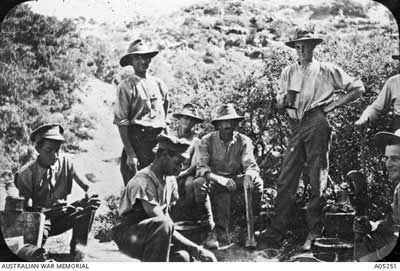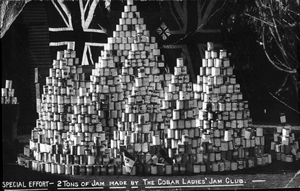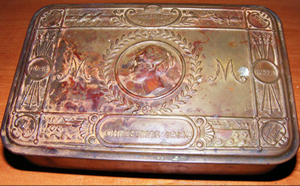Science and technology Stage 2
Overview

Gallipoli 1915: a group of Anzacs making a meal
©Public domain (AWM A05251)
Students investigate the physical properties of hard tack biscuits that were a staple food ration for service people on the front in the First World War. They make hard tack biscuits and observe changes in the ingredients in the making and during baking. They test the properties of the baked biscuits and make connections between the properties and their use in the war.
Teaching and learning activities

Two tons of jam made by the Cobar Ladies Club for WW1 troops, c. 1916
©Public domain (State Library of NSW)
How did the physical properties of the food rations of the First World War influence their use?
Question and predict
-
Explain that food with a long shelf life and requiring no refrigeration needed to be produced and sent to the First World War troops. Tinned bully beef and hardtack biscuits were the staple of most meals.
-
Show students images of a hardtack biscuit. Students research and describe their properties. Hardtack biscuit images: Army hardtack biscuit; Daily life; Anzac biscuits.
-
Compare the appearance of the biscuits to everyday biscuits. Discuss the manufacture of these, emphasising the changing state due to adding heat (baking).
-
Ask students to predict the ingredients of hardtack biscuits and method of production.
-
Show students the raw ingredients of hardtack and ask them to predict what changes will occur when mixed and heated.
Investigate
-
In groups, students follow the original Arnott’s recipe to make hardtack biscuits.
-
Students examine, magnify, photograph and describe the physical properties of each ingredient prior to mixing: as dough, rolled and cut, halfway through baking, and after baking.
-
Students test and record the properties of the baked hard tack biscuits, such as taste, breakability, durability.
-
As a comparison, students could research current Australian Defence Force army rations and record their properties.
-
As an extension activity, the process of freeze-drying foods could be researched. A freeze-dried meal could be cooked, observed and tasted.
Process and analyse data and information
-
Students document the process and observed changes in their science journal, including labelled diagrams.
-
Students describe the properties of hardtack biscuits based on their test results.
-
Students compare the ingredients and properties of hardtack to savoury biscuits today. They describe how and why they are used in everyday life.
-
Students generate ideas about how the physical properties of savoury biscuits and other long-lasting foods influence their use.
Communicate
-
Students explain and describe how scientific knowledge about the effects of baking (heating) is used by people in their everyday life.
-
Students explain the physical properties of hardtack biscuits and other First World War food items and how the properties influence their use.
-
Students provide and lead the class in baking other long-life biscuit recipes, for example, Anzac biscuits.
Learning concepts

Princess Mary’s 1914 Christmas gift tin
These additional questions can be used for discussion or further investigations.
Challenge
There were thousands of troops to feed, no refrigeration and long distances: Food.
What foods were sent to the troops to meet these challenges?
Change
The Australian Red Cross sent food and other items to provide a change from the army rations provided, for example, tinned and dried fruit.
What properties of fresh fruit and vegetables made them unsuitable as war food?
Caring
The Australian First World War AIF uniform was unique.
What properties of the fabrics suited their particular purposes in the uniform design?
What design features of the uniform helped care for our First World War soldiers?
Community
Princess Mary's Christmas Gift: Princess Mary, the 17-year-old daughter of King George V, raised funds to send a gift tin to every soldier for Christmas 1914. This contained lollies and other items.
What properties would the items in the Christmas gift tin need to possess?
Syllabus links
ST2-4WS investigates their questions and predictions by analysing collected data, suggesting explanations for their findings, and communicating and reflecting on the processes undertaken.
ST2-12MW identifies that adding or removing heat causes a change of state between solids and liquids
ST2-13MW identifies the physical properties of natural and processed materials, and how these properties influence their use
Working scientifically
Students question and predict by:
-
predicting what might happen based on prior knowledge in an investigation (ACSIS053, ACSIS064)
Students plan investigations by:
-
working collaboratively and individually, to suggest ways to plan and conduct investigations to find answers to questions (ACSIS054, ACSIS065)
-
suggesting appropriate materials, tools and equipment they could use in conducting their investigations and recording their findings, identifying appropriate safety rules
Students conduct investigations by:
-
following the planned method, adjusting procedures as necessary, including exploration, fieldwork, surveys and researching secondary sources
-
safely using appropriate materials, tools or equipment to make and record observations, using formal measurements and digital technologies as appropriate (ACSIS055, ACSIS066)
Students process and analyse data and information by:
-
using a range of methods including tables and simple column graphs to represent data and to identify patterns and trends, using digital technologies as appropriate (ACSIS057, ACSIS068)
-
comparing results with predictions, suggesting possible reasons for findings (ACSIS215, ACSIS216)
Students communicate by:
-
representing and communicating ideas and findings in a variety of ways such as diagrams, physical representations and simple reports, tables, simple column graphs, written and oral factual texts, explanation and argument (ACSIS060, ACSIS071)
Material world
A change of state between solid and liquid can be caused by adding or removing heat. (ACSSU046)
Students:
-
describe some everyday situations where solids and liquids change state by adding heat (heating) or removing heat (cooling)
-
predict and observe the effects of adding heat or removing heat on a variety of everyday solids and/or liquids, for example, butter, chocolate and water
-
describe how scientific knowledge about the effects of heating and cooling is used by people in their everyday life
Natural and processed materials have a range of physical properties which influence their use. (ACSSU074)
Students:
-
observe the changes that occur in the physical properties of everyday materials when they are heated, cooled, bent, stretched, folded and twisted
-
observe and describe the structure of materials that can be seen with the naked eye and a magnifying glass, eg grains in bread, particles in chipboard or cork, threads within a fabric or fibres in paper
-
identify the properties of some natural and processed materials
-
describe how a range of common natural and processed materials are used in everyday life
-
generate ideas about how the physical properties of some natural and processed materials influence their use